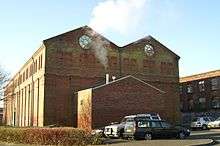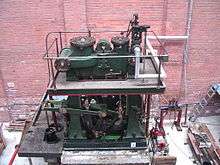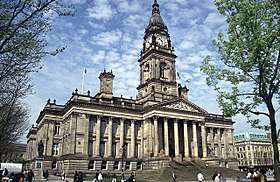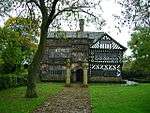Bolton Steam Museum



an inverted vertical compound engine rescued from Hardman and Ingham's Diamond Rope Works at Royton, near Oldham
Bolton Steam Museum is a museum in Bolton, Greater Manchester, England, which houses a variety of preserved steam engines. Based in the cotton store of the former Atlas Mill in Mornington Road, it is owned and run by the Northern Mill Engine Society (NMES).[1]
Overview
The NMES is a registered charity (No 532259) and the museum has received Accredited Museum status from Arts Council England, the government body responsible for museums policy. The museum is open most Wednesdays and Sundays between 10 am and 2 pm when visitors can view the engines statically when volunteers are working at the museum. Special Open Days are held each year on Bank Holidays weekends when the engines are working under steam power. However, visits by genuine enthusiasts or organised groups can always be accommodated by prior arrangement. (See website). Vehicular access is via Morrisons's Supermarket car park. Parking is free for museum visitors.
Steam engines
The following is a list of the mill engines that have been preserved and are on show at Bolton Steam Museum. For further details of the engine types, see steam engine.
- Crossfield Mill Beam Engine
- A twin-beam engine, of unknown make, with gear drive flywheel, circa 1840, from the Crossfield Mill, Wardle, Lancashire
- Wasp Mill Tandem
- A tandem compound engine with Corliss valve gear built by J & W McNaught Ltd of Rochdale in 1902 for the Wasp Mill, Wardle, Lancashire
- Parks St Mill NDC
- A "non-dead-centre" inverted vertical compound engine, built by John Musgrave and Sons of Bolton in 1893, using Fleming and Ferguson patents, for Park Street Mill, Radcliffe, Lancashire
- Diamond Rope Works
- An inverted vertical compound engine with Corliss valve gear built by Scott & Hodgson Ltd of Guide Bridge in 1914 for Hardman and Ingham’s Diamond Rope Works, Royton, Lancashire
- Cellarsclough Beam Engine
- A McNaughted compound single beam engine (originally c 1870) modified by Woodhouse and Mitchell of Brighouse in 1908 for Cellarsclough Mill, Marsden, Huddersfield, Yorkshire
- Robey Uniflow
- A single-cylinder horizontal Uniflow engine built by Robey of Lincoln in 1926, originally for the Baltic Sawmills, Ammanford, South Wales.
- Robey Cross Compound
- A twin cylinder cross-compound engine built by Robey of Lincoln in 1935 for the laboratories of the University of Manchester Institute of Science and Technology.
- Barraclough Vertical
- A single cylinder "A-frame" vertical engine built by Joseph Barraclough of Barnsley in circa 1860 for Redfearn's Glassworks, Barnsley, South Yorkshire.
- Chadwick Vertical
- A vertical engine built by John Chadwick Ltd of Manchester, that was used to pump water in Cellarsclough Mills at Marsden
- Browett & Lindley
- A high-speed compound inverted vertical engine built in 1900 by Browett, Lindley & Co of Patricroft driving an early two-pole dynamo by J H Holmes of Newcastle, from Lakefield Mill, Farnworth, Bolton
- Tangye Horizontal
- A single-cylinder horizontal engine by Tangye of Birmingham from Vantona Textiles Ltd of Farnworth
- Langbridge Diagonal
- A twin–cylinder diagonal engine built by Lang Bridge Ironworks of Accrington for textile printing machinery driving, from Bollington Printworks, Cheshire
- Walker Fire Pump
- A single cylinder horizontal rotative fire pump engine built by Walkers of Radcliffe circa 1890 for the Fern Mill, Shaw, Lancashire
- Other Engines
- A further 12 smaller steam engines of different designs by various makers
- A rare Musgrave barring engine, used to turn the large mill engines into the start position, a procedure that was originally done by "barring" the flywheel by hand. This engine was in the Bolton Museum's collection but has been transferred to this museum which is only a few yards from its original working place in atlas No 6 Mill.
See also
References
External links
| Wikimedia Commons has media related to Bolton Steam Museum. |


